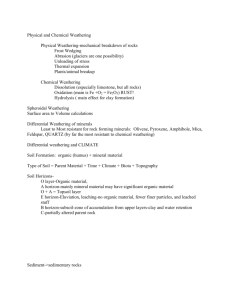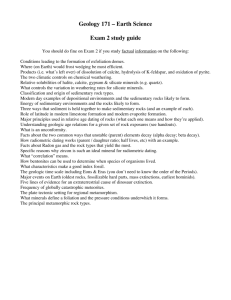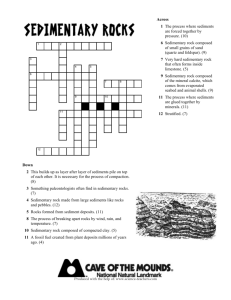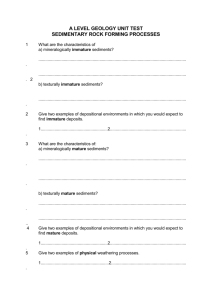Lecture 12: Surface Processes I
advertisement
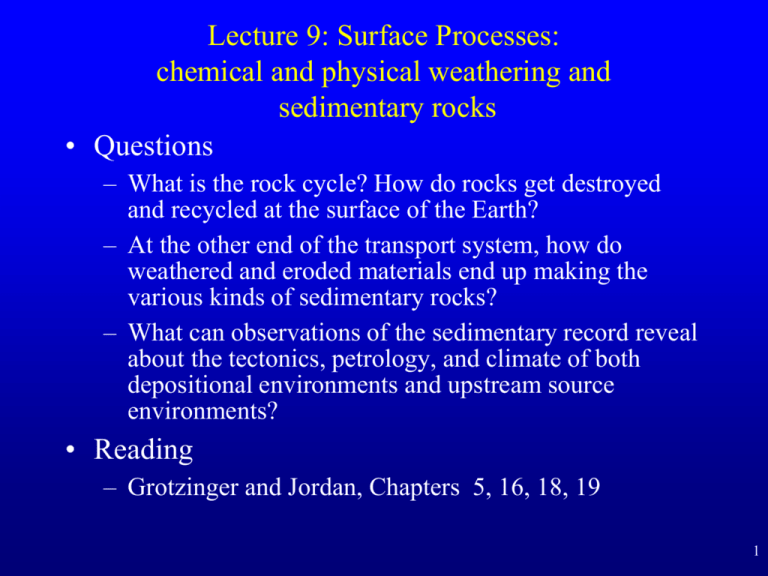
Lecture 9: Surface Processes: chemical and physical weathering and sedimentary rocks • Questions – What is the rock cycle? How do rocks get destroyed and recycled at the surface of the Earth? – At the other end of the transport system, how do weathered and eroded materials end up making the various kinds of sedimentary rocks? – What can observations of the sedimentary record reveal about the tectonics, petrology, and climate of both depositional environments and upstream source environments? • Reading – Grotzinger and Jordan, Chapters 5, 16, 18, 19 1 Weathering and Sedimentation in the Rock Cycle • Our geology so far has focused on internally-driven processes: plate tectonics, magmatism, metamorphism, orogeny. • The rest of geology is driven by surface processes: the hydrologic cycle (rainfall, streams, ice), gravity, aqueous chemistry. • Weathering and erosion are the processes that form and transport form sediment. • Sedimentation, burial and lithification are the processes that transform weathering products into sedimentary rocks. 2 Weathering and Sedimentation in the Rock Cycle • A more detailed view of the surface-driven parts of the rock cycle shows the various steps between source rock and sedimentary product 3 Weathering: decomposition of rocks • There is a distinction between weathering and erosion: – Weathering converts exposed rock to soil in place – Erosion transports dissolved or fragmented material from the source area where weathering is occurring to a depositional environment . – Most of the earth’s surface is covered by exposure of sediment or sedimentary rock, by area. – But the sediment layer is thin in most places, with respect to overall crustal thickness, so sedimentary rock is a minor volume fraction of the crust (in part by definition: once buried to the mid-crust, sediments get cooked to metasediments). 4 Weathering: chemical and physical • The destruction of rocks at the Earth’s surface by weathering has two fundamental modes of operation: – Chemical weathering is dissolution or alteration of the original minerals, usually by reactions with aqueous solutions • Chemical weathering puts ions from the source minerals into solution for subsequent erosion by transport in flowing water as dissolved load. – Physical weathering is fragmentation into progressively smaller particles, from intact outcrop to boulders and on down to mineral fragments and sand grains. • Physical weathering makes loose pieces of rock available for downslope movement by mass wasting or transport in flowing water as suspended or bed load. 5 Chemical Weathering • Chemical weathering is driven by thermodynamic energy minimization, just like chemical reactions at high temperature. – The system seeks the most stable assemblage of phases. – The differences are that (1) kinetics are slow and metastability is common; (2) the stable minerals under wet, ambient conditions are different from those at high T and P; (3) solubility in water and its dependence on water chemistry (notably pH) are major determinants in the stability of minerals in weathering. • A fresh rock made of olivine and pyroxenes will end up as clays and iron oxides, with other elements in solution • A fresh rock made of feldspars and quartz will end up as clays, hydroxides, and quartz in most waters. 6 Chemical Weathering 7 Chemical Weathering • The most common alteration product of feldspars is kaolinite, Al2Si2O5(OH)4, which serves as a model for the formation of clays by weathering generally. – The reactions of feldspars to kaolinite illustrate some of the basic trends: • • • • K, Na, Ca are highly soluble and readily leached by chemical weathering. Excess Si can be removed as silicic acid although quartz is relatively insoluble. Al is extremely insoluble, and is essentially conserved as source rock is converted to clays. Weathering is a hydration process, leaving H2O bound in the altered minerals. – 2 KAlSi3O8 + 9 H2O + 2 H+ -> Al2Si2O5(OH)4 + 2 K+ + 4 H4SiO4 • Note the H+ on the left-hand side…only acidic water can drive this reaction • Natural waters are acidic due to equilibrium of carbonic acid with CO2 in the atmosphere – CO2 (g) + H2O = H2CO3 – 2 KAlSi3O8 + 9 H2O + 2 H2CO3 -> Al2Si2O5(OH)4 + 2 K+ + 4 H4SiO4 + 2HCO3– – Alteration of rock transforms acidic rainwater into neutral surface or ground water, with bicarbonate the dominant species (relative to CO2 and CO32–). – Mg and Fe2+ are also readily leached, but Fe3+ is very insoluble…the ultimate residue of alteration of mafic rocks is hematite. 8 Chemical Weathering • Knowing the chemistry of reaction of minerals to kaolinite, it is possible to reconstruct from the dissolved ions in stream water the amount of each source mineral that reacted with the water. • Questions: How do you do the correction for atmospheric input? Do the source minerals in the Sierra Nevada all weather at equal rates? 9 Chemical Weathering • Some minerals are congruently soluble in acidic water, leaving no residue – The most abundant is calcite: CaCO3 + H2CO3 = Ca2+ + 2HCO3– (the Tums reaction) – Effects of dissolution (and precipitation) of calcite can be dramatic, to say the least. Sinkhole Karst terrain Speleothems 10 Rates of Chemical Weathering • Many factors affect the rate at which a rock will weather, as summarized here. • Some of these variables are local (e.g., source rock), some are global. These include temperature and pCO2, leading to the CO2weathering feedback cycle. 11 Physical Weathering • Anything that promotes disaggregration of a rock so that pieces can form soil or be eroded away by wind, water, or gravity transport is physical weathering. – The distinction between physical weathering and erosion is subtle, but think of physical weathering as fragmenting the rock and erosion as carrying the fragments away; at times these may be the same event, of course. • Rocks that are jointed or faulted or have pre-existing weak zones are most easily weathered. – Few of the stresses associated with physical weathering are significant compared to the tensile strength of intact rocks; something, has to start the process, either initial cracks and weaknesses or chemical attack on mineral cohesion. • Organisms, especially plants (think tree roots), are fond of breaking up rocks. • Freeze-thaw, frost wedging, frost heave…the volume change between ice and water is effective in widening cracks in rock in suitable climates. • Physical abrasion by flowing air or water, or more often by rock particles already mobilized by water or wind (think Fossil Falls). • Tectonics…rocks caught in a fault zone are definitely undergoing physical weathering. • Etc. 12 Weathering feedbacks: chemical and physical • Physical weathering and chemical weathering generally proceed in parallel in most environments. • Physical and chemical weathering promote one another: – Formation of cracks by physical weathering increases reactive surface area, promoting chemical weathering. – Chemical weathering replaces intact interlocking minerals with weak clays or void space, making the rock easier to physically disaggregate, promoting physical weathering 13 Weathering feedbacks: more generally • Weathering of both kinds plays key roles in several feedbacks. • Tectonics affects weathering through slopes and elevations, climate affects weathering through temperatures (via chemical kinetics and freezethaw), rainfall, pCO2, etc. • Conversely, weathering and erosion affect tectonics and climate: – Denudation by erosion must be isostatically compensated and so affect vertical motions of the crust… – Weathering controls water chemistry, courses of streams and groundwater, removes CO2 from the atmosphere, etc. 14 Soil formation • Chemically and physically weathered rock that is not eroded or transported but remains in place becomes soil. • A weathered surface develops a stratified structure, with intact rock at the bottom (or inside) and maximum weathering at the top . • Leachable ions are transported downwards by groundwater flow, possibly redeposited as water chemistry adjusts towards equilibrium with the developing 15 soil profile. Soil formation • The mineralogy and thickness of soil layers depends on source rock, climate (temperature and rainfall), and age. • Which of these soil types would you rather farm? 16 Erosion and Transport • Between weathering and sedimentation, matter must be transported from source to destination. This is erosion. – We dealt with the landforms generated by erosion in the geomorphology lecture; here our concern is with the effects of transport on sedimentary rocks. • Modes of transport: – Gravity (short distances and steep slopes) – Wind (small particles only) – Glaciers – Water • Surface runoff carries dissolved, suspended, and bed loads • Groundwater flow only carries dissolved load – All these mechanisms carry products of physical weathering and insoluble residues of chemical weathering. – Only water transport carries away leached soluble products of chemical weathering. 17 Erosion and Transport • Certain modes of transport physically modify and physically and chemically sort particles en route. • Size sorting by surface water runoff flow: Current of a given velocity can generally carry all noncohesive particles smaller than a critical size; since current velocity drops with decreasing slopes from mountains to lowlands, it follows that sediments evolve from poorly sorted and coarse-grained near source to well-sorted and finer grained with increasing transport distance. 18 Erosion and Transport • Chemical sorting with increasing transport distance is like a continuation of chemical weathering: most stable minerals are transported the farthest. • Textures of particles are modified by abrasion during wind or water transport. Close to source particles are angular; far from source particles are rounded. 19 Sedimentation • Eventually transported particles and dissolved ions reach a place where they can be permanently deposited and accumulated. This is sedimentation. • The sedimentary rocks that result from this accumulation are controlled by and record the sedimentary environment where they were deposited. – We interpret ancient sedimentary rocks by comparison to modern environments where we can observe ongoing sedimentary processes and relate them to the composition, texture, and structure of the resulting rocks. 20 Sedimentation • Sediments and the environments in which they form are fundamentally divided into clastic and chemical: – Clastic sediments are made of physically transported and deposited particles (they may later gain chemically grown cement during diagenesis) – Chemical sediments are grown from solution, organically or inorganically; biochemical sediment more specifically refers to minerals grown from solution by organisms • In some cases the relationship between the environment and the character of the sediment is absolute and obvious (carbonate in reefs, boulder-strewn till in periglacial deposit, etc.); other cases are more subtle. 21 Diagenesis • The process of modification of newly deposited sediments into sedimentary rocks is diagenesis or lithification. – Processes include: • physical compaction by the pressure of overburden, accompanied by expulsion of pore waters • Growth of new diagenetic minerals and continued growth of chemical sediments from pore waters. • Dissolution of soluble elements of clastic rocks. • Recrystallization and remineralization as water chemistry, pressure, and temperature evolve. • At the high-T and P end, diagenesis merges smoothly into the low-T and P end of metamorphism. The distinction is arbitrary. 22 Sedimentary Rocks • The preserved end-result of weathering, erosion, transport, sedimentation, and diagenesis is sedimentary rocks. – Like sediments and sedimentary environments, the resulting rocks are divided into clastic (or siliciclastic or volcaniclastic, etc.) and chemical (or biochemical). • Clastic rocks are classified by particle size (and sorting) and composition. 23 Sedimentary Rocks • Chemical sediments are primarily classified, of course, by mineralogical composition. 24 Sedimentary rocks and environmental information • How do sedimentary rocks preserve information about their depositional environments? – By composition, mineralogy and grain size, obviously, but also through sedimentary structure • Elements of sedimentary structure: – Bedding • Bed thickness, from finely laminated to massive Burgess Shale: fine Vasquez formation: massive 30 m 30 cm 25 Sedimentary structure • Character of bedding, from simple horizontal laminae to cross-bedding, ripples, soft-sediment deformation, or bioturbated. • Cross-bedding indicates high and unidirectional current velocity, often winds in terrestrial settings, forming sand dune lee-slopes. • Ripple marks record back-and-forth action by waves in shallow water. 26 Sedimentary Structure • Mud cracks demonstrate drying-out of a thin layer of sediment fine enough to have significant cohesion. Definite proof of terrestrial setting or very shallow water marginal marine. MODERN ANCIENT • What about this structure? (Hint: it is not the surface of the Moon) 27 Sedimentary Structure • Soft-sediment deformation indicates slumping or compression of layers before complete lithification. • Bioturbation is the vertical mixing of sedimentary layers by burrowing organisms. Evidence of such activity can be preserved on bedding surfaces as trace fossils. Indicative of water depth, availability of nutrients and oxygen, etc. 28 Sedimentary Structure • Graded Bedding: sorting of particle sizes within beds indicates time dependence and hence process of deposition – An environment in which a episodes of high-energy transport give way to periods of low-energy transport gives normal graded beds: – Alluvial settings, with wandering channels that fill up and become overbank deposits – Continental slopes with turbidity currents 29 Carbonate Rocks • Most carbonate rocks are entirely biochemical sediment, made up of the body parts of calcite or aragonite-precipitating organisms – Deep-sea carbonate ooze is made of foram shells – Reef carbonates are made of coral reefs (usually) – Stromatolites are formed by carbonate precipitation by microorganisms 30 Tour of sedimentary environments Let us go through each of the major categories of sedimentary environment, keeping in mind the relationship between observable processes in modern settings and the preserved features in ancient examples, and the ways in which observation of a sedimentary rock formation can be used to infer the type of setting and detailed information about it. 31 Sedimentary environments: Terrestrial I. Fluvial (rivers and streams of all kinds and sizes) a. Alluvial Fans We saw alluvial fans on the field trip. They form where drainages exit mountain fronts onto surrounding lowlands. Individual fans may merge to form a piedmont slope (like Pasadena). In arid regions like California, sediment transport on alluvial fans is dominated by debris flows like mudslides and landslides, and by periodic stream flows that divide the fan into channel and overbank deposits. Sorting is poor, but increases downstream; grain size decreases downstream; sediments are often oxidized and poor in fossils or organic matter. 32 Sedimentary environments: Terrestrial I. Fluvial b. River systems Rivers are classified into meandering or braided, most often. Braiding is favored by high sediment load, steep gradients, variable stream flow, and unstable poorly vegetated banks. Meandering is favored by the opposite. 33 Sedimentary environments: Terrestrial I. Fluvial b. River systems Meandering rivers develop in a fairly regular pattern by channel migration, leaving a predictable sequence of cyclic, fining-upward sedimentary deposits. Braided river deposits are more chaotic leave somewhat random deposits, since channels wander randomly across the floodplain. 34 Sedimentary environments: Terrestrial • II. Desert environment • Deserts basins are basically alluvial fans, playas, and sand dunes. They may be dominated by wind transport or by fluvial transport restricted to rare, seasonal storms and floods • Alluvial fans are debris flow and stream flow deposits (as above). • Playas are dry or seasonal lake beds dominated by evaporites or fine-grained and finely laminated mudstones and siltstones. • Sand dunes leave fascinating cross-bedded to massive sandstone deposits. • Sustained deposition of wind-blown dust makes thick deposits of loess. 35 Sedimentary environments: Terrestrial • III. Lacustrine (i.e., lakes) • Lakes are special, compared to rivers and oceans, in several ways: – Small size (no large waves), absence of tides, and low currents makes lakes very low-energy sedimentary environments. Coarse sediments are limited to their margins. – Lakes generally keep all sediment that arrives from a large drainage area, so sedimentation rates are high, often ten times higher than marine settings. – Open lakes (with inlet and outlet streams) are usually fresh-water and generate only clastic sediments. Closed basin lakes become saline and lead to chemicaldominated sedimentation. Many lake deposits show cyclic alternations between closed and open conditions. Annual variations in sediment supply (especially if the lake freezes over each winter) are often preserved in low-energy lacustrine depositional environments as countable annual layers or varves. Varves 36 Sedimentary environments: Terrestrial • IV. Glacial and peri-glacial • We saw some of the typical valley glacier deposits on the field trip. But there is more to the glacial environment than moraines and tills. – Glaciers generate characteristic river deposits (frequently braided) and lake deposits (frequently varved) when they terminate on land, and characteristic marine deposits when they terminate in the ocean (dropstones). They move large boulders, but they also generate huge amounts of very fine rock flour that ends up as mud or loess. Periglacial deposits, like most sedimentary sequences, have several facies: a basal till deposited in front of the glacier is overlain by moraines, lake sediments, glacio-fluvial deposits, and finally loess. 37 Sedimentary environments: Marginal Marine • I. Deltaic environment: Deltas form wherever rivers empty into oceans or lakes. Much of the clastic load carried to the mouth of the river is deposited in a restricted area at or near the coast, forming a delta. – Because deltas prograde outwards, they build deposits with reverse grading, coarsening upwards as the delta moves past a given location. – The forces affecting sedimentation in a delta are fluvial, tidal, and waves, and different deltas display effects of dominance by different forces. The Mississippi delta is fluvial-dominated: Both tides and waves are weak in the Gulf of Mexico, so distribution of sediment is dominated by the river itself, which forms long, relatively stable channels (life span ~1000 years) with levees; each channel narrows upwards until it pinches off. 38 Sedimentary environments: Marginal Marine • I. Deltaic environment • Flow at the mouth of a fluvial-dominated delta is controlled by the relative density of river outflow and ambient sea-water. Depending on river sediment load and temperature (and on ocean salinity and temperature), the flow may be hyperpycnal (river outflow denser), or hypopycnal (river outflow less dense). – Hyperpycnal flow leads to turbidite deposits from sediment-rich flows along the bottom. Hypopycnal flow leads to uniform, well-sorted sediments since in this case settling is controlled by flocculation of fine particles. 39 Sedimentary environments: Marginal Marine • The Ganges-Brahmaputra delta is tide-dominated – Although the river outflow is higher and more sediment-laden than the Mississippi, the tidal range is large (about 4 meters). This type of delta breaks up into sand bars and channels oriented parallel to the tidal inflow-outflow direction. There is a large, intermittently exposed, tidal flat. • The Sao Francisco river in Brazil is wave-dominated – Wave-energy here is 100 times that at the Mississippi. Sediments reaching the mouth of the river are rapidly reworked and redistributed by longshore currents to build beaches, barriers, and lagoons, similar to stretches of coast where no river is present. 40 Sedimentary environments: Marginal Marine II. Beach-barrier environment Any continental margin where there is not a river mouth is likely to form a beach with a single shoreface or a beachbarrier island-lagoon system • A beach produces a distinctively ordered set of recognizable facies, from dune sands through the surf zone, breaker zone and into deeper water. • A barrier complex has a lagoon and often a swamp deposit behind the barrier. 41 II. Beach-barrier environment Sedimentary environments: Marginal Marine If a simple beach is prograding, i.e. building out to sea and depositing near-shore facies on top of distal facies, it might produce a stratigraphic column like this, coarsening upwards and hence clearly distinct from any river floodplain or continental slope deposit. Keep in mind the relationship between the lateral succession of environments at any constant time across a beach and the vertical succession of sediments shown in a column like this one. 42 Sedimentary environments: Marginal Marine III. Estuarine environment • An estuary is a partly enclosed body of water at the mouth of a river. It may be part of a delta; it may be the lagoon behind a barrier-island. Generally, estuaries must have a connection to the open ocean at least at high tide. They are environments of mixing between seawater and freshwater. Example: San Francisco Bay IV. Tidal flats • A wide, flat area of land between low-tide level and high-tide level is a tidal flat. These are common environments for deposition of carbonates and evaporites. They may be associated with deltas, beaches, or estuaries 43 Sedimentary environments: Marine I. Neritic environments • This term refers to depths below wave-base and low tide, and above the shelf-slope break. – At times of sea level highstand, when shallow seas cover the continental platforms, the neritic environment may encompass a significant fraction of the earth’s area. – The neritic environment is where carbonate reefs are built. 44 II. Oceanic environments Sedimentary environments: Marine • Continental slope deposits are characterized by turbidites, cyclic fining- upward sedimentary sequences that form by turbidity flows of suspended sediment down the moderately steep slopes of the continental slope. • Deep sea (abyssal) deposits There is a clear regional pattern with areas dominated by chemical sediment (carbonate ooze or siliceous ooze) or by a very slow accumulation of fine clastic particles (pelagic clay). We will develop the ocean chemistry and geology to understand this pattern... 45




